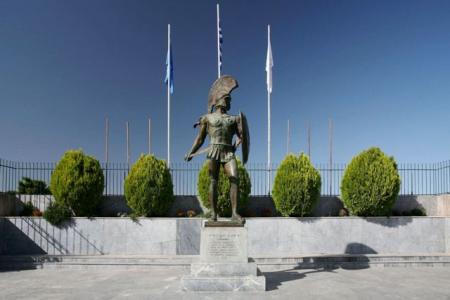Throughout his training regime in the lead up to his fight against Teofimo Lopez, undisputed Lightweight Champion of the world, Greek Australian George Kambosos demonstrated humility, character and a Greek fighting spirit that you can trace back to Ancient Sparta.
The same spirit that defied the Persians against all odds.
The same spirit that defied the Ottomans in the 1821 Greek revolution against all odds.
The same spirit that defied the Italians and Germans in World War II against all odds.
The same spirit that animated George Kambosos and led him to defy the punters, the commentators and all the doubters to become Australia and Greece’s greatest boxing story.
Even after his victory, Kambosos displayed a remarkable level of composure and humility, offering an olive branch to his ‘enemy’, suggesting they forget about the rivalry and focus on enjoying their families and beautiful children.
Lopez had no ears for peace. Instead, he went on a rant insisted he had won the match, which triggered loud boos from the audience which had cheered him on at the start of the match. They would have none of it. George won it fair and square, a fact that was acknowledged by all the crowd irrespective of their alliances.
During the post match interview, Kambosos reminded the audience that he represented both Greece and Australia, and that both countries would be celebrating his win, and he wasn’t wrong.
Kambosos shed blood, sweat and tears to make every Greek and every Australian proud and for that we are grateful to him.
Just like King Leonidas, Kambosos defied his adversary and told him, if you want the Victory, COME AND GET IT! – the very Spartan spirit that George Kambosos has emblazoned on his heart, tats and clothing!
ΜΟΛΟΝ ΛΑΒΕ!
(Molón Lavé)

RESOURCE | ABOUT “MOLON LAVE”
MOLON LAVE meaning ‘come and take [them]’, is a classical expression of defiance. It is among the Laconic phrases reported by Plutarch, attributed to King Leonidas I in reply to the demand by Xerxes I that the Spartans surrender their weapons. The exchange between Leonidas and Xerxes occurs in writing, on the eve of the Battle of Thermopylae.
Modern Use: Greece
Modern use of ‘ΜΟΛΩΝ ΛΑΒΕ’ as a military motto appears to originate in the Kingdom of Greece during the First World War or the Greco-Turkish War. The motto is on the emblem of the I Army Corps of Greece and the Second Infantry Division of Cyprus.[year needed] The phrase was inscribed on the Thermopylae monument (1955), using an archaic script that would be appropriate for the time of the Persian Wars.
During the Cyprus Emergency between Greek Cypriot insurgents and British troops, Cypriot leader Grigoris Afxentiou on 3 March 1957 became surrounded by British forces outside his secret hideout near the Machairas Monastery near Lazanias, Nicosia.The British troops requested him to surrender his arms, but Afxentiou shouted molon labe in reply. Unable to flush him out and sustaining several casualties, the British forces resorted to pouring gasoline into his hideout and lighting it.
Modern Use: United States
Allusion to the phrase in translation (“come and take it!”) is recorded in the context of the Revolutionary War, noted in 1778 at Fort Morris in the Province of Georgia, and later in 1835 at the Battle of Gonzales during the Texas Revolution where it became a prevalent slogan.
Use of the original Greek in the United States is more recent. Its use by militia organizations is reported for the 1990s or early 2000s. It is the motto of the Special Operations Command Central (SOCCENT).
Modern Use: Texas Revolution
In early January 1831, prior to the Texan Revolution, Green DeWitt wrote to Ramón Músquiz, the top political official of Bexar, and requested armament for defense of the colony of Gonzales. This request was granted by delivery of a small used cannon. The small bronze cannon was received by the colony and signed for on 10 March 1831, by James Tumlinson, Jr. The swivel cannon was mounted to a blockhouse in Gonzales and later was the object of Texan pride.
At the minor skirmish known as the Battle of Gonzales — the first battle of the revolution against Mexican rule – a small group of Texans successfully resisted the Mexican forces who had orders from Colonel Domingo de Ugartechea to seize their cannon. As a symbol of defiance, the Texans had fashioned a flag containing the phrase “come and take it” along with a black star and an image of the cannon that they had received four years earlier from Mexican officials. This was the same message that was sent to the Mexican government when they told the Texans to return the cannon; lack of compliance with the initial demands led to the failed attempt by the Mexican military to take the cannon back forcibly.
Replicas of the original flag can be seen in the Texas State Capitol, the Bob Bullock Texas State History Museum, the Sam Houston State University CJ Center, the University of Texas at El Paso Library, the Marine Military Academy headquarters building, Hoblitzelle Auditorium of the Hockaday School, and in Perkins Library at Duke University.



